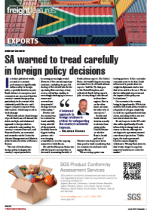Known for their exceptional quality and unique f lavour profiles, South African wines have gained global recognition and acclaim. However, the industry has recently faced a setback, with a 5% decline in export volumes. While this may seem like a significant challenge, industry experts agree that it is just a bump in the road, and the industry remains poised for continued growth and success.Maryna Calow, communications manager for Wines of South Africa (Wosa), said the industry remained focused on its road to recovery following the pandemic. “What has been positive is that while our volumes declined by 5%, the export value only saw a decline of 2.4%, with rand per litre on the whole showing marginal growth as producers navigate rising costs, shipping challenges and shortages in the supply of packaging goods.”Asked about the outlook for 2023, Calow said it was too early to say how the rest of the year would look and compare to 2022. “The first quarter exports are unfortunately lower than expected. There is a myriad of challenges faced by the industry at the moment. Some of the challenges include increased input costs, higher inf lation, increased fuel costs, load-shedding, and issues at the local ports. A weakened rand makes it expensive to import dry goods such as corks and barrels, while machinery and marketing activities abroad are incredibly costly when currency is converted.”She said at present South Africa was not moving away from any markets, with the main focus being on Canada, the USA, the UK, Germany, the Netherlands, Sweden, China, Hong Kong, Japan and key African countries. “We see great opportunity for growth on the African continent, the USA and the Far East in particular. Some of our markets are going through a more challenging time than others, but there hasn’t been consistent negative change anywhere that is seeing us refocus our strategy to move away from any markets at the moment.”She said the UK, South Africa’s largest export wine market, had seen growth of 5% in volumes in 2022. Higher-priced bulk exports drove the volume growth, with 8% growth in rand per litre. The Chinese market had however slowed down. This was attributed to the extended extreme lockdown measures imposed in the country in 2022, which led to an overall decline in wine consumption.Germany, South Africa’s second-largest market, saw a decline of 17% in value and 9% in volume. Exports in Africa remained noteworthy from both a volume and value perspective.Calow said efforts to drive bulk exports were continuing, while alternative sustainable packaging had become a hot topic.

